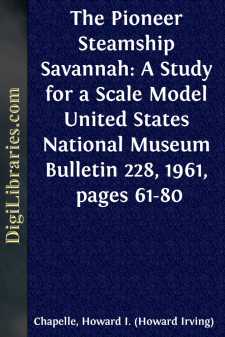Categories
- Antiques & Collectibles 13
- Architecture 36
- Art 48
- Bibles 22
- Biography & Autobiography 813
- Body, Mind & Spirit 142
- Business & Economics 28
- Children's Books 15
- Children's Fiction 12
- Computers 4
- Cooking 94
- Crafts & Hobbies 4
- Drama 346
- Education 46
- Family & Relationships 57
- Fiction 11828
- Games 19
- Gardening 17
- Health & Fitness 34
- History 1377
- House & Home 1
- Humor 147
- Juvenile Fiction 1873
- Juvenile Nonfiction 202
- Language Arts & Disciplines 88
- Law 16
- Literary Collections 686
- Literary Criticism 179
- Mathematics 13
- Medical 41
- Music 40
- Nature 179
- Non-Classifiable 1768
- Performing Arts 7
- Periodicals 1453
- Philosophy 64
- Photography 2
- Poetry 896
- Political Science 203
- Psychology 42
- Reference 154
- Religion 513
- Science 126
- Self-Help 84
- Social Science 81
- Sports & Recreation 34
- Study Aids 3
- Technology & Engineering 59
- Transportation 23
- Travel 463
- True Crime 29
The Pioneer Steamship Savannah: A Study for a Scale Model United States National Museum Bulletin 228, 1961, pages 61-80
Categories:
Description:
Excerpt
The Pioneer Steamship
SAVANNAH:
A Study for a Scale Model
The original plans of the pioneer transatlantic steamer Savannah no longer exist, and many popular representations of the famous vessel have been based on a 70-year-old model in the United States National Museum. This model, however, differs in several important respects from contemporary illustrations.
To correct these apparent inaccuracies in a new, authentic model, a reconstruction of the original plans was undertaken, using as sources the ship's logbook and customhouse description, a French report on American steam vessels published in 1823, and Russian newspaper accounts contemporary with the Savannah's visit to St. Petersburg on her historic voyage of 1819. The development of this research and the resulting information in terms of her measurements and general description are related here.
The Author: Howard I. Chapelle is curator of transportation in the United States National Museum, Smithsonian Institution.
The United States National Museum has in its watercraft collection a rigged scale model purported to be of the pioneer transatlantic steamer Savannah. For many years this model was generally accepted as being a reasonably accurate representation and was the basis for countless illustrations. Curiously enough, the model (USNM 160364) does not agree with the published catalog description as to the side paddle wheels. Neither does it agree with the material in the Marestier report, which is accepted as the only source for a contemporary picture of the Savannah.
The recent naming of an atomic-powered ship in honor of the famous steamer greatly increased popular interest in the pioneer ship and its supposed model. Consequently, the National Museum undertook the research necessary to correct or replace the existing model. This research has been carried out by the staff of the Museum's transportation division with the aid of Frank O. Braynard of the American Merchant Marine Institute, Eugene S. Ferguson, curator of mechanical and civil engineering at the Museum, and others.
The Savannah crossed from Savannah, Georgia, to Liverpool, England, in the period May 22 to June 20, 1819; and proceeded to the Baltic, where she entered at St. Petersburg (now Leningrad), Stockholm, and a few other ports. On her return she reached Savannah on November 30, and on December 3 she sailed for Washington, D.C., arriving on December 16. Her original logbook now on exhibition in the Museum, covers the period between March 28, 1819, when she first left New York for Savannah, to December 1819 when she was at Washington.
Figure 1.—Old model of theSavannah, built under the supervision of Captain Collins. This model has been removed from exhibition in the United States National Museum because of inaccuracies. (USNM160364;Smithsonian photo14355.)The old model () was built about 1890–1892 by Lawrence Jenson, a master shipwright and model builder of Gloucester and Rockport, Massachusetts, under the supervision of Capt. Joseph Collins of the U.S....




